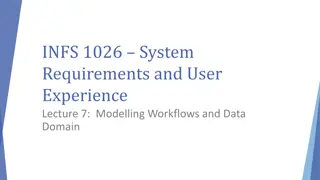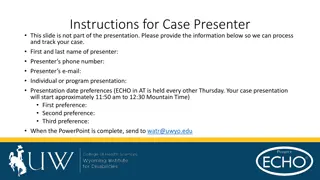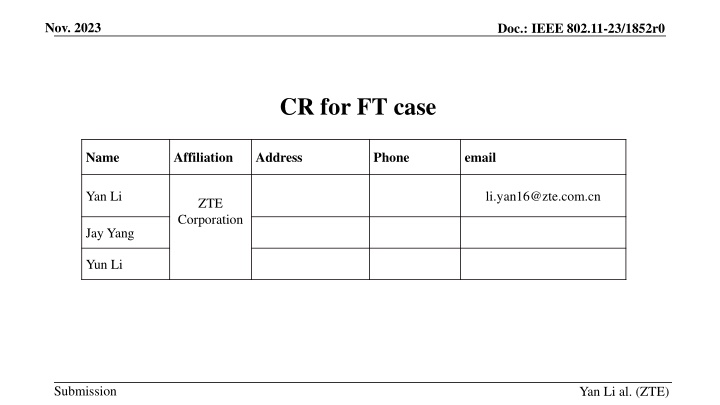
IEEE 802.11-23/1852r0 Fast Transition Protocol Updates
Explore the proposed changes and resolutions for Fast Transition protocol enhancements in IEEE 802.11-23/1852r0. The discussions cover the possibility of changing MAC addresses, ensuring valid FT keys, and supporting ID/MAC address changes during Fast BSS Transition. Discover the key hierarchy, methods, and signalings involved in the FT protocol revisions.
Download Presentation

Please find below an Image/Link to download the presentation.
The content on the website is provided AS IS for your information and personal use only. It may not be sold, licensed, or shared on other websites without obtaining consent from the author. If you encounter any issues during the download, it is possible that the publisher has removed the file from their server.
You are allowed to download the files provided on this website for personal or commercial use, subject to the condition that they are used lawfully. All files are the property of their respective owners.
The content on the website is provided AS IS for your information and personal use only. It may not be sold, licensed, or shared on other websites without obtaining consent from the author.
E N D
Presentation Transcript
Nov. 2023 Doc.: IEEE 802.11-23/1852r0 CR for FT case Name Affiliation Address Phone email Yan Li li.yan16@zte.com.cn ZTE Corporation Jay Yang Yun Li Submission Yan Li al. (ZTE)
Nov. 2023 CID Doc.: IEEE 802.11-23/1852r0 Comment Proposed Change Resolution 131 IRM is currently only part of 4-way handshake. The MAC address used for next association should be possible to change also in Fast Transition. Allow STA to use different MAC address in each Fast BSS Transition. Please add possibility to signal the next MAC address in the FT signalign. Revised. Agree with the commenter in principle. As the FT key hierarchy is established by the fixed mac address of the non-AP STA we have to consdier a method to guarantee both of AP and non-AP STA can use valid FT key in the case of random mac address. The next few slides provide two potential resolutions and corresponding signalings. 136 IRM is currently only part of 4-way handshake. The MAC address used for next association should be possible to change also in PASN setup. Allow STA to use different MAC address in each Fast BSS Transition. Please add possibility to signal the next MAC address in the FT signaling. Revised. The comment and proposed change indicate different cases. The PASN case has been resolved in D1.0. If the commenter want to propose the FT case, i agree with the comment in principle. As the FT key hierarchy is established by the fixed mac address of the non-AP STA we have to consdier a method to guarantee both of AP and non-AP STA can use valid FT key in the case of random mac address. The next few slides provide two potential resolutions and corresponding signalings. 274 The draft supports changing the Device ID or IRM MAC address at Reassociation, but does not appear to support such change when using FT (which is the popular way to do Reassociation, now). Consider a method to support ID/MAC Address changing with FT protocol Revised. Agree with the commenter in principle. As the FT key hierarchy is established by the fixed mac address of the non-AP STA we have to consdier a method to guarantee both of AP and non-AP STA can use valid FT key in the case of random mac address. The next few slides provide two potential resolutions. Submission Yan Li, et al. (ZTE)
Nov. 2023 Doc.: IEEE 802.11-23/1852r0 Recap of FT protocol FT(Fast BSS transition) FT key hierarchy PMK-R0 PMK-R1 PTK FT procedure includes: FT initial mobility domain association FT protocol FT protocol includes two methods: over-the-Air over-the-DS Submission Slide 3 Yan Li, et al. (ZTE)
Nov. 2023 Doc.: IEEE 802.11-23/1852r0 Recap of FT key hierarchy(1) FT key hierarchy has three levels of keys(i.e. PMK-R0,PMK-R1 and PTK)[1]. The construction of FT key hierarchy is shown as the right figure. R0KH derives the PMK-R0 from MPMK and should be responsible for maintaining PMK-R0 and deriving a PMK-R1 for each R1KH R1KH maintians PMK-R1 and derives PTK Submission Slide 4 Yan Li, et al. (ZTE)
Nov. 2023 Doc.: IEEE 802.11-23/1852r0 Recap of FT key hierarchy(2) The MAC address of non-AP STA is one of the input parameter to generate PMK-R0 and PMK-R1. as both of S0KH-ID and S1KH-ID are the SPA where Submission Slide 5 Yan Li, et al. (ZTE)
Nov. 2023 Doc.: IEEE 802.11-23/1852r0 Recap of FT procedure FT procedure can be divided into two parts: initial mobility domain association(as the figure 13-2) FT protocol (as the figure 13-5) FTO should use the same MAC address in initial association and FT protocol. The PMKR1Name along with the MAC address of FTO will be stored in the target AP after the initial association FTO(non-AP STA) sends authentication request carrying PMKR0Name the target AP will derive PMKR1Name based on the recived PMKR0Name and FTO MAC address, and verify whether the new derived PMKR1Name matches the stored PMKR1name Submission Slide 6 Yan Li, et al. (ZTE)
Nov. 2023 Doc.: IEEE 802.11-23/1852r0 Motivation Due to the trackable issue concern during FT procedure, some venders may be in favor of the usage of RMA. However, a new problem is that the target AP can t recognize and match the corresponding PMKR1 to the STA with RMA in FT case according to the analysis above. Now two features(device ID and IRM) defined by TGbh allow the non-AP STA using a different MAC addresss in the FT case to enhance security requirement. In the next few slides, two options are introduced to settle the FT key hierarchy issue[1] Note 1-the FT key hierarchy is derived from the current mac address(SPA) of the FTO.When the mac address of FTO is changed, AP can t recognize it and find the correct key. Submission Slide 7 Yan Li, et al. (ZTE)
Nov. 2023 Doc.: IEEE 802.11-23/1852r0 Option 1: generate new PMK-R1s In the initial associaiton, AP1 gets the IRM of STA1 AP1 forwards IRM(assuming such IRM for FT case) to R0KH R0KH generates PMKR1s based on the IRM according to the FT key hierarchy for STA1, and distributes a new PMKR1 to each R1KH S0KH also generates and delivers a new PMKR1 to S1KH before or during roaming When STA1 roams to AP2, both of them use the new PMK-R1 along with IRM Once a new IRM is provided to R0KH in FT procedure, the R0KH and S0KH will generate new PMKR1s for next roaming. In this option, new PMK-R1s should be generated each time before STA1 roams in the ESS(from the aspect of the ESS, STA1 is recognized as a new STA, because a new hierarchy(i.e., original PMKR0, new PMKR-R1s and PTKs based on IRM) has been established for it) Slide 8 Submission Yan Li, et al. (ZTE)
Nov. 2023 Doc.: IEEE 802.11-23/1852r0 Option 2: Reuse the PMK-R1s (11bh identifer maps to the original MAC address of the STA) In the initial associaiton, AP1 gets the IRM from STA1, or provides Device ID to STA1 AP1 maps the 11bh identifier(IRM/Device ID) to the STA original MAC address used in the initial association AP1 shares the mapping info. to the other APs in the same ESS(via the R0KH or by direct way) When STA1 with 11bh identifier roams to AP2, the target AP will recognize the STA1 and use the stored PMK-R1 of the STA1 using original MAC address. In this option, the original FT key hierarchy(established in the initial associaiton) can always be reused when STA1 roams in the ESS(from the aspect of the ESS, STA1 with random mac address is always recognized as the STA with the mac address used in the initial association) Submission Slide 9 Yan Li, et al. (ZTE)
Nov. 2023 Doc.: IEEE 802.11-23/1852r0 Signaling For the initial association, the signaling for IRM/Device ID exchange is in the 4-way handshake,which has been resolved in the 11bh Draft 1.0 For the FT protocol( i.e., transition), new elements(IRM and Device ID) need to be added in the optional parameter(s) field in the FTE for next roaming The optional parameters field in the FTE can be encrypted[1] Note 1:following the simialr way as GTK delivery in the optional parameter(s) of the FTE in baseline Submission Slide 10 Yan Li, et al. (ZTE)
Nov. 2023 Doc.: IEEE 802.11-23/1852r0 Signaling for Device ID An instance for signaling of Device ID : authenticaiton request(message 1) carries[1] the plaintext Device ID in the FTE reassociation response(message 4) carries the encrypted Device ID for assigning a new ID for the STA Note 1:message 1 shall carry the Device ID for the FT authentication and the Device ID is unencrypted because PTKSA hasn t been negotiated at this time Submission Slide 11 Yan Li, et al. (ZTE)
Nov. 2023 Doc.: IEEE 802.11-23/1852r0 Signaling for IRM An instance for signaling of IRM : reassociation request(message 3) carries the encrypted IRM to provide a new mac address for the next association Submission Slide 12 Yan Li, et al. (ZTE)
Nov. 2023 Doc.: IEEE 802.11-23/1852r0 Summary Option IRM support Device ID support Modification of the SPEC Impact in implementation 1.generates new PMKR-R1s yes no[1] define a new procedure to generate new PMK-R1 for the STA once a new IRM is provided extra computational cost to get a new PMK-R1 if a new IRM provided 2.reuse the PMK-R1s yes yes make and share the mapping info(11bh identifier to STA original MAC) among all the APs the ESS only share the new remapping info once a new 11bh identifier provides. In summary, Option 2 seems to be simpler on the modification of the SPEC and implementation, comparing to Option 1 Note 1- when AP1 provides only Device ID to the R0KH, R0KH can t generate new PMKR1s without MAC address of STA1 for the next association. Submission Slide 13 Yan Li, et al. (ZTE)
Nov. 2023 Doc.: IEEE 802.11-23/1852r0 Straw Poll Which one do you support to settle FT key hierarchy issue[1]: Option 1 : generate new PMK-R1s Option 2 : reuse the PMK-R1s(11bh identifer maps to the original MAC address of the STA) Note 1-the FT key hierarchy is derived from the current mac address(SPA) of the FTO.When the mac address of FTO is changed, AP can t recognize it and find the correct FT key. Submission Slide 14 Yan Li, et al. (ZTE)
Nov. 2023 Doc.: IEEE 802.11-23/1852r0 THANK YOU Submission
Nov. 2023 Doc.: IEEE 802.11-23/1852r0 Reference [1] Draft P802.11REVme_D3.0 [2] Draft P802.11bh_D1.0 Submission Slide 16 Yan Li, et al. (ZTE)


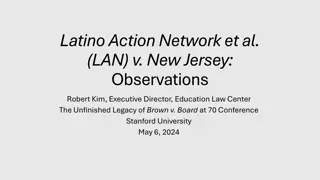
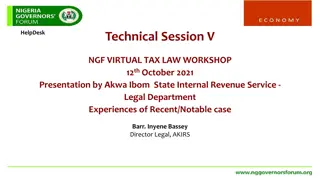







![Comprehensive Case Study on [Insert Case Title Here]](/thumb/159705/comprehensive-case-study-on-insert-case-title-here.jpg)





